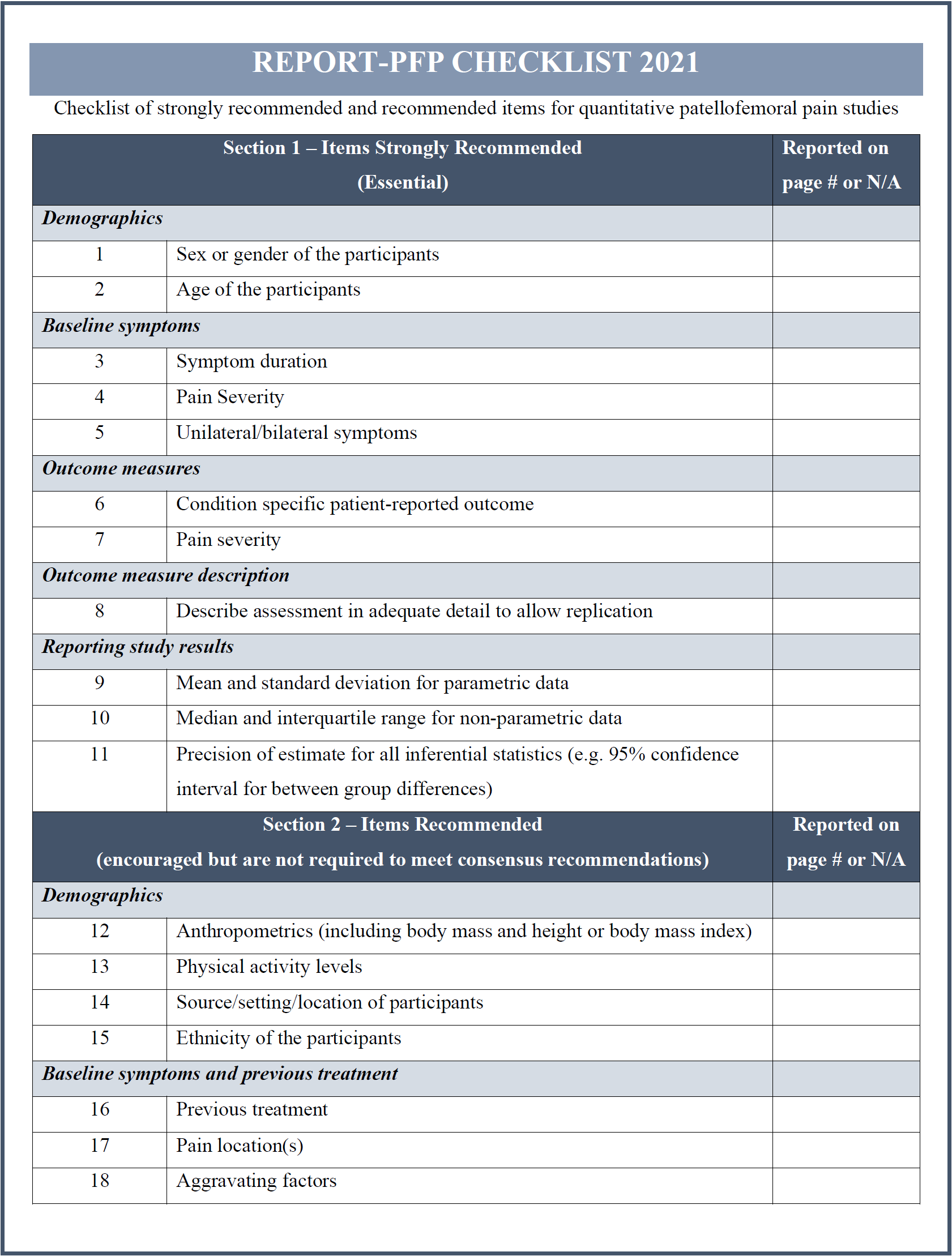REPORT-PFP Checklist
We have developed a clearly defined, and widely accepted set of agreed-upon standards for REPORTing of quantitative PatelloFemoral Pain studies.
Download PDF version of REPORT-PFP Checklist
Download Word version of REPORT-PFP Checklist
Read the development paper here (http://dx.doi.org/10.1136/bjsports-2020-103700)
Our goal with this checklist is to enhance research translation to clinical practice, facilitate more trustworthy evidence synthesis, and guide clinicians on how to contribute to research and data collection in their practice.
Here we have suggestions for what tools you can use to report each of the checklist items. These recommendations were made by an iPFRN expert panel using a robust, structured consensus research process.


References supporting the checklist items
Crossley KM, Bennell KL, Cowan SM, et al. Analysis of outcome measures for persons with patellofemoral pain: which are reliable and valid? Arch Phys Med Rehabil 2004;85(5):815-22.
Kujala UM, Jaakkola LH, Koskinen SK, et al. Scoring of patellofemoral disorders. Arthroscopy 1993;9(2):159-63. doi: 10.1016/s0749-8063(05)80366-4
Crossley KM, Macri EM, Cowan SM, et al. The patellofemoral pain and osteoarthritis subscale of the KOOS (KOOS-PF): development and validation using the COSMIN checklist. Br J Sports Med 2018;52(17):1130-36. doi: 10.1136/bjsports-2016-096776 [published Online First: 2017/03/03]
Booth M. Assessment of physical activity: an international perspective. Res Q Exerc Sport 2000;71 Suppl 2:114-20. doi: 10.1080/02701367.2000.11082794
AIHW. The Active Australia Survey: A guide and manual for implementation, analysis and reporting: Australian Institute of Health and Welfare; 2003 [Available from: https://www.aihw.gov.au/reports/physical-activity/active-australia-survey/contents/table-of-contents accessed November 5 2020.
Tegner Y, Lysholm J. Rating systems in the evaluation of the knee ligament injuries. Clin Orthop 1985;198:43-49.
O’Loughlin J, Dugas E, Maximova K, et al. Reporting of ethnicity in research on chronic disease: update. Postgrad Med J 2006;82(973):737-42. doi: 10.1136/pgmj.2005.048074
Boudreau SA, Kamavuako EN, Rathleff MS. Distribution and symmetrical patellofemoral pain patterns as revealed by high-resolution 3D body mapping: a cross-sectional study. BMC Musculoskelet Disord 2017;18(1):160. doi: 10.1186/s12891-017-1521-5
Roos EM, Roos HP, Lohmander LS, et al. Knee Injury and Osteoarthritis Outcome Score (KOOS)–development of a self-administered outcome measure. J Orthop Sports Phys Ther 1998;28(2):88-96. doi: 10.2519/jospt.1998.28.2.88
de Oliveira Silva D, Pazzinatto MF, Priore LBD, et al. Knee crepitus is prevalent in women with patellofemoral pain, but is not related with function, physical activity and pain. Phys Ther Sport 2018;33:7-11. doi: 10.1016/j.ptsp.2018.06.002
de Oliveira Silva D; Barton CJ; Briani RV; Taborda B; Ferreira AS; Pazzinatto M; Azevedo FM. Kinesiophobia, but not strength is associated with altered movement in women with patellofemoral pain. Gait & Posture 2019;68:1-5. doi: 10.1016/j.gaitpost.2018.10.033
Schiphof D, van Middelkoop M, de Klerk BM, et al. Crepitus is a first indication of patellofemoral osteoarthritis (and not of tibiofemoral osteoarthritis). Osteoarthritis Cartilage 2014;22(5):631-8. doi: 10.1016/j.joca.2014.02.008 [published Online First: 2014/02/26]
Kamper SJ, Maher CG, Mackay G. Global rating of change scales: a review of strengths and weaknesses and considerations for design. J Man Manip Ther 2009;17(3):163-70. doi: 10.1179/jmt.2009.17.3.163
Collins N, Crossley K, Beller E, et al. Foot orthoses and physiotherapy in the treatment of patellofemoral pain syndrome: randomised clinical trial. BMJ 2008;337:a1735.
Euroquol. EQ-5D instruments 2020 [Available from: https://euroqol.org/eq-5d-instruments/ accessed October 23 2020.
Rand. 36 item short form survey (SF-36) 2020 [Available from: https://www.rand.org/health-care/surveys_tools/mos/36-item-short-form.html accessed October 23 2020.
Rand. 12 item short form survey (SF-12) 2020 [Available from: https://www.rand.org/health-care/surveys_tools/mos/12-item-short-form.html accessed October 23 2020.
Thomeé P, Währborg P, Börjesson M, et al. A new instrument for measuring self-efficacy in patients with an anterior cruciate ligament injury. Scand J Med Sci Sports 2006;16(3):181-7. doi: 10.1111/j.1600-0838.2005.00472.x
Ezzat AM, Whittaker JL, Brussoni M, et al. The English Knee Self-Efficacy Scale is a valid and reliable measure for knee-specific self-efficacy in individuals with a sport-related knee injury in the past 5 years. Knee Surg Sports Traumatol Arthrosc 2020 doi: 10.1007/s00167-020-05974-x [published Online First: 2020/04/17]
Nicholas MK. The pain self-efficacy questionnaire: Taking pain into account. Eur J Pain 2007;11(2):153-63. doi: 10.1016/j.ejpain.2005.12.008 [published Online First: 2006/01/30]
Miller R, Kori S, Todd D. The Tampa Scale: a measure of kinesiophobia. Clin J Pain 1991;7:51-52.
Waddell G, Newton M, Henderson I, et al. A Fear-Avoidance Beliefs Questionnaire (FABQ) and the role of fear-avoidance beliefs in chronic low back pain and disability. Pain 1993;52(2):157-68. doi: 10.1016/0304-3959(93)90127-b
Sullivan M, Bishop S, Pivik J. The pain catastrophising scale: development and validation. Psychol Assess 1995;7:524-32.
EQUATOR Network [Available from: https://www.equator-network.org/.
Hoffman T, al. e. Better reporting of interventions: template for intervention description and replication (TIDieR) checklist and guide. BMJ 2014;348:g1687.
Slade SC, Dionne CE, Underwood M, et al. Consensus on Exercise Reporting Template (CERT): Explanation and Elaboration Statement. Br J Sports Med 2016;50(23):1428-37. doi: 10.1136/bjsports-2016-096651 [published Online First: 2016/10/05]
Slade SC, Dionne CE, Underwood M, et al. Consensus on Exercise Reporting Template (CERT): Modified Delphi Study. Phys Ther 2016;96(10):1514-24. doi: 10.2522/ptj.20150668 [published Online First: 2016/05/05]
Toigo M, Boutellier U. New fundamental resistance exercise determinants of molecular and cellular muscle adaptations. Eur J Appl Physiol 2006;97(6):643-63. doi: 10.1007/s00421-006-0238-
Holden S, Rathleff MS, Jensen MB, et al. How can we implement exercise therapy for patellofemoral pain if we don’t know what was prescribed? A systematic review. Br J Sports Med 2017 doi: 10.1136/bjsports-2017-097547 [published Online First: 2017/10/30]
